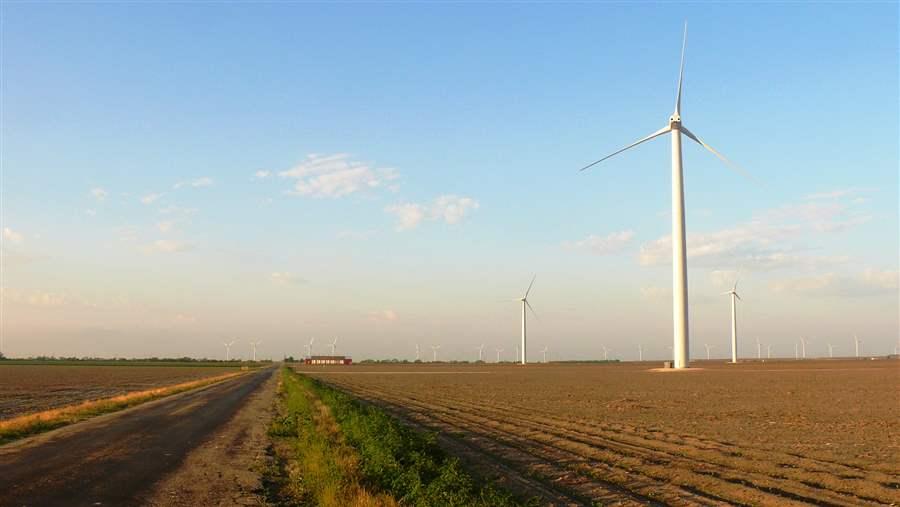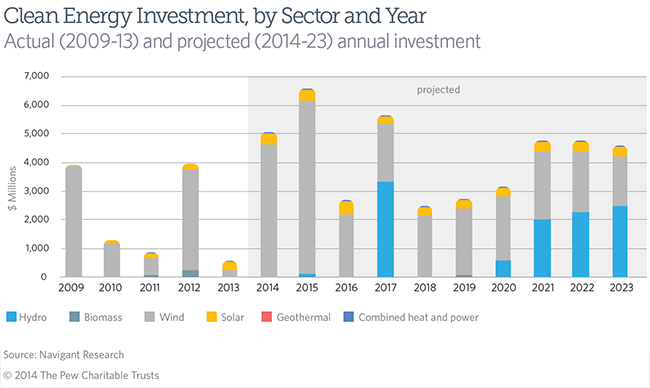Texas Winds Generate Economic Growth
Clean economy rising
Overview
Texas is a giant in the domestic power industry. Among the 50 states, it is the largest generator of electricity, has the only independent electric grid within its borders, offers the greatest resource potential for wind and solar, and contains the largest installed capacity of industrial energy efficiency technologies.1 Prime renewable resources and policies encouraging clean energy deployment have enabled the state to dominate national rankings in several clean energy sectors.2 This brief examines the reasons for Texas' success in wind power and its growing leadership in other renewable energy technologies.
 © E.ON North America
© E.ON North AmericaThe Roscoe Wind Farm
Clean energy policies
Texas’ electricity sector is unlike any other in the nation. While the rest of the United States is divided into two main power grids transporting electricity to the east and west, most of Texas has its own grid, which is managed by ERCOT, the Electric Reliability Council of Texas.3
It is also one of only a handful of states with a deregulated electricity market, with customers free to select their own retail providers and utilities able to adjust rate and service offerings without prior approval from the Public Utilities Commission. Nearly 60 percent of customers in the state live in competitive areas; those with electric cooperatives or municipal utilities may be subject to local regulation.4 While the benefits and challenges of this model have been greatly debated, opening the power market to competition in 2002 helped promote renewable energy.5 In many areas of the state, electricity generated from wind is becoming the most cost-effective option.6

The state’s modest renewable portfolio standard set a goal of installing 5.9 gigawatts of renewable energy by 2015, enough to meet approximately 5 percent of peak demand, and 10 GW by 2025. Texas surpassed the latter target in 2010, 15 years ahead of schedule, but does not appear poised to adopt a more aggressive goal.7 It also was the first state to call for utilities to meet increased energy demand by raising energy efficiency requirements to a specific percentage. This energy efficiency resource standard currently requires utilities to meet 30 percent of annual growth in electricity demand through efficiency.
Clean energy installations are eligible for corporate and property tax deductions or exemptions, as well as low-interest loans.8 These incentives reduce or eliminate upfront capital costs so projects can begin achieving cost savings shortly after installation.9
Endnotes
- U.S. Energy Information Administration, “Electric Power Monthly” (July 28, 2014), Table 1.6.A. Net Generation, http://www.eia.gov/ electricity/monthly/epm_table_grapher.cfm?t=epmt_1_6_a; “Solar Energy,” Window on Statement Government, http://www.window. state.tx.us/specialrpt/energy/renewable/solar.php; A. Lopez et al., U.S. Renewable Energy Technical Potentials: A GIS-Based Analysis, National Renewable Energy Laboratory (July 2012): 10-14, http://www.nrel.gov/docs/fy12osti/51946.pdf; and U.S. Department of Energy, “Combined Heat and Power Installation Database,” http://www.eea-inc.com/chpdata/.
- American Wind Energy Association, “Texas Wind Energy” (2013), http://www.awea.org/Resources/state.aspx?ItemNumber=5183; and Solar Foundation, “State Solar Jobs: Texas” (2013), http://thesolarfoundation.org/solarstates/texas.
- Energy Information Administration, “What Is the Electric Power Grid, and What Are Some Challenges It Faces?” last updated April 27, 2012, http://www.eia.gov/energy_in_brief/article/power_grid.cfm; and Electric Reliability Council of Texas, “About ERCOT” (2005), http://www.ercot.com/about.
- Power Across Texas, “Issue Brief: Resource Adequacy” (May 30, 2013), http://poweracrosstexas.org/wp-content/uploads/2013/05/ PAT-2013-Issue-Brief-Resource-Adequacy.pdf; and Texas Comptroller of Public Accounts, The Texas Economy, “Competitive Electricity Markets in Texas: A Primer,” http://thetexaseconomy.org/natural-resources/articles/article.php?name=competitiveElectricity.
- Office of the Governor, The Texas Renewable Energy Industry (2014): 4, http://governor.state.tx.us/files/ecodev/renewable_energy.pdf.
- Keith Johnson, “Blown Away: Wind Power Makes Electricity Cheaper in Texas” (Aug. 10, 2009), Environmental Capital, http://blogs.wsj. com/environmentalcapital/2009/08/10/blown-away-wind-power-makes-electricity-cheaper-in-texas/.
- North Carolina State University, Database of State Incentives for Renewables and Efficiency, “Texas Incentives/Policies for Renewables and Efficiency: Renewable Generation Requirement,” last updated Aug. 4, 2014, http://www.dsireusa.org/incentives/incentive.cfm?Incentive_Code=TX03R&re=0&ee=0; and North Carolina State University, Database of State Incentives for Renewables and Efficiency, “Texas Incentives/Policies for Renewables and Efficiency: Energy Efficiency Goal,” last updated July 6, 2012, http://www.dsireusa.org/incentives/incentive.cfm?incentive_code=TX28R.
- North Carolina State University, Database of State Incentives for Renewables and Efficiency, “Local Option—Contractual Assessments for Energy Efficient Improvements” (July 16, 2013), http://www.dsireusa.org/incentives/incentive.cfm?Incentive_Code=TX81F&re=1&ee=1; and State Energy Conservation Office, “Texas Tax Code Incentives for Renewable Energy,” http://www.seco.cpa.state.tx.us/re/incentives-taxcode-statutes.php.
- Keeping PACE in Texas, “Why PACE is Attractive to Property Owners” (Sept. 2014), http://www.keepingpaceintexas.org/wp-content/uploads/2014/09/Property-OwnerCVH.pdf.






